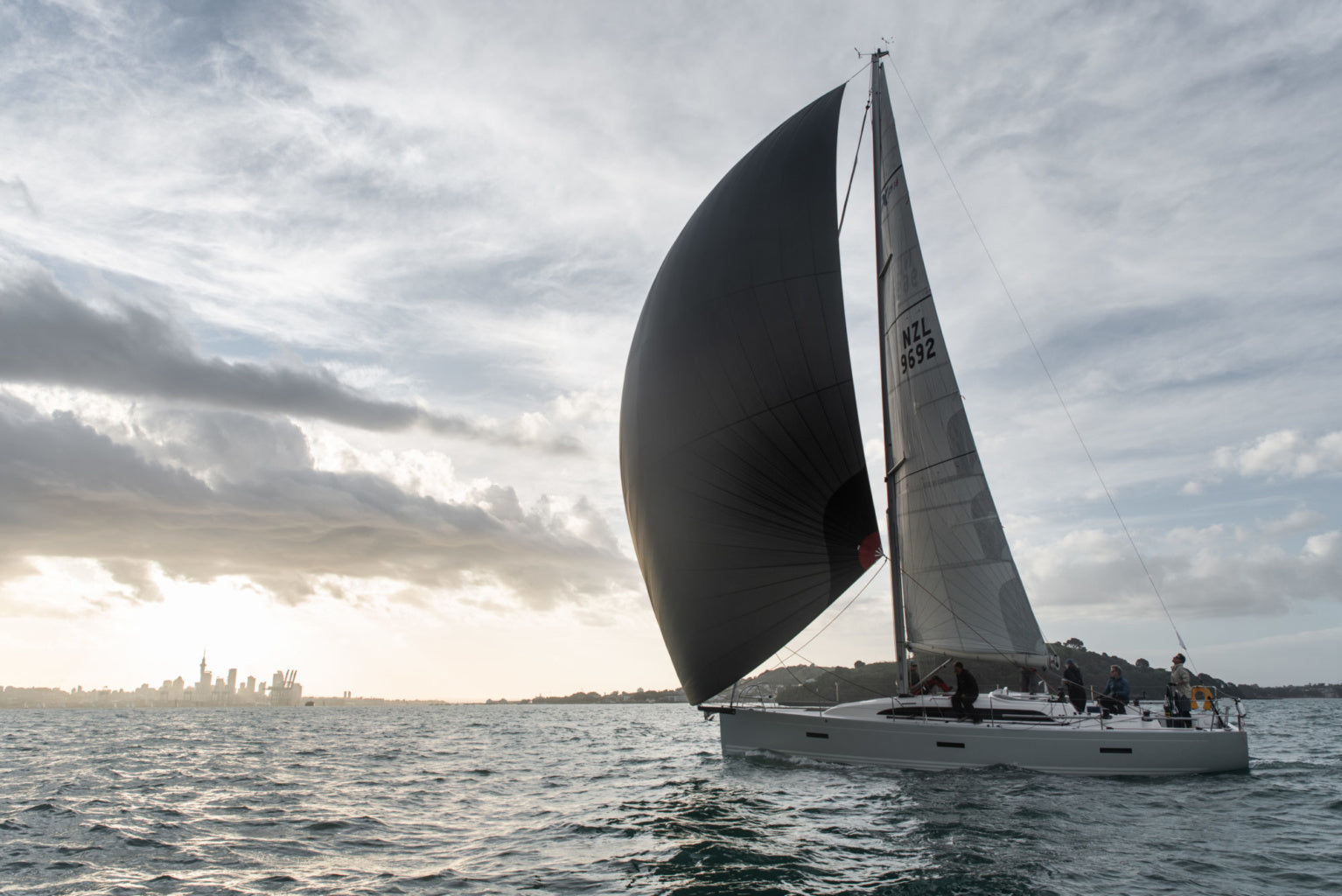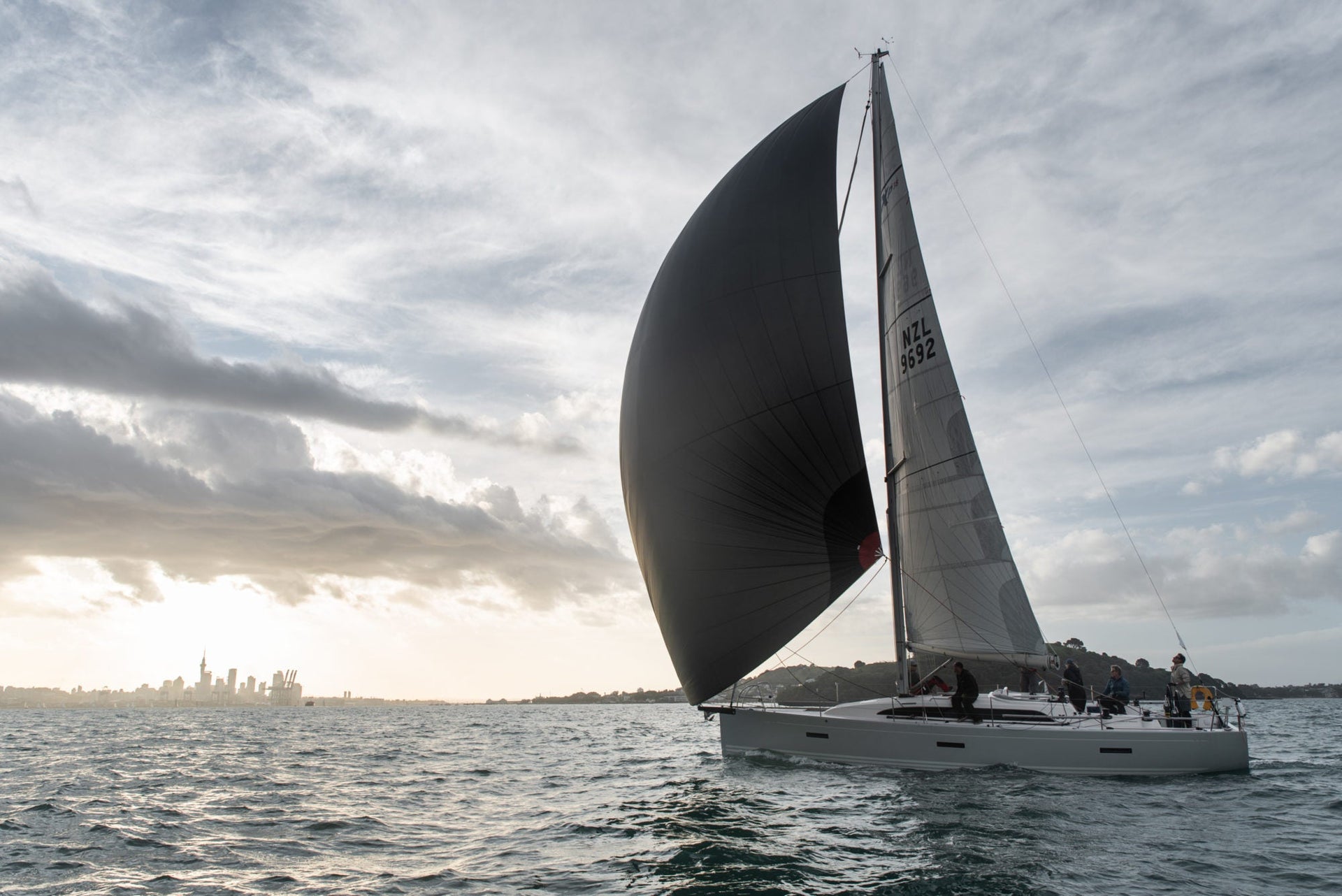THE DIFFERENCE BETWEEN A SPINNAKER AND A GENNAKER
Understanding these two sail types can help you figure out which will be best for your boat.

Like the Spork (a combination of spoon and fork), the name gennaker came from combining two very different sail types into one: a genoa and a spinnaker. Unlike the spork, gennakers are an entirely new sail type that demonstrate the sailing industry’s leading edge.
What exactly is a gennaker? In short, a gennaker has a genoa’s form (asymmetric, head and tack pinned, sheets tied to the clew) with the wide girth of a spinnaker. The gennaker is an all-purpose downwind sail, while spinnakers are built for specific downwind apparent wind angles.
Because designs are changing so quickly, the term gennaker can seem complicated. First, let’s make sure we understand the two original sail types: the spinnaker and the genoa.
What is a Spinnaker?
A popular online dictionary defines spinnaker as: “a large three-cornered sail, typically bulging when full, set forward of the mainsail of a yacht when running before the wind.” When spinnakers were all symmetric, that dictionary definition would’ve been fine.
Today, things are a bit more complicated.
Symmetric Spinnakers and Asymmetric Spinnakers
We now describe the spinnakers in the picture below as symmetric spinnakers. Divide one in half vertically, and the two sides are mirror images. The windward corner is held out with a pole attached to the windward side of the mast, and to change course (or jibe), that pole is switched to the opposite corner. Unlike a headsail, there is no defined tack or clew; both are clews, until the pole is attached and that corner becomes the tack.
(Told you it was complicated.)

Symmetric spinnakers remain a viable sail type for downwind sailing on boats equipped with spinnaker poles and the necessary running rigging. They fly well when sailing “deep,” with the spinnaker pole squared well aft – or as the dictionary says, “when running before the wind.”
Over the past few decades, another spinnaker type has become increasingly popular – the asymmetric spinnaker or “A-sail.” An asymmetric spinnaker has three distinct corners:
- the head (attached to the halyard and hoisted all the way up the mast);
- the tack (attached by a short adjustable tackline to the bow/bowsprit);
- the clew (attached to the two sheets that run down each side of the boat).
Hmm, that sounds a lot more like a jib or genoa…
Asymmetric spinnakers are popular on boats that have permanent bowsprits or retractable poles. They are also used by cruising sailors because they are easier to handle than symmetric spinnakers.
While symmetric spinnakers and asymmetric spinnakers look different, they are both spinnakers under the measurement guidelines of most racing rules. We won’t go into the specifics of sail measurement protocols here, but the purpose is to see that spinnakers carry substantial girth (width) and are therefore useful when reaching/running. A wide, curvy, sail like this simply won’t fly upwind.

What is a Genoa?
If you google ‘Genoa’, this is what you will probably find: “a large jib or foresail whose foot extends aft of the mast, used especially on racing yachts.” All jibs and genoas are asymmetric; divide one in half vertically, and the two resulting pieces are hardly mirror images. Here again, the racing rule measurement guidelines help further define the standard form of a jib or genoa:
- Triangular, with not nearly as much girth as a spinnaker,
- with only one corner (the clew) allowed to roam freely (with sheets attached to keep it under control).

What is a Gennaker?
One day several years ago, someone thought: “maybe we should take a genoa’s form (asymmetric dimensions, head and tack pinned down, a couple of sheets tied to the clew) and give it more girth, like a spinnaker. That’s just crazy enough to work! But what to call this genoa/spinnaker?” And so was born the gennaker.
A gennaker won’t fly upwind like a genoa. And it’s not as efficient as a spinnaker built for specific downwind apparent wind angles. But a gennaker fits the bill nicely as an all-purpose downwind sail for reaching/(almost) running. And because no spinnaker pole is needed, a gennaker is a lot easier to rig and fly than a symmetric spinnaker.
A gennaker has the asymmetric form of a genoa with the girth (width) of a spinnaker.
Is a Gennaker for Cruising or Racing?
Is a gennaker a cruising sail or a racing sail? Yes. Depending. Many racing rules require a specific minimum girth measurement for a spinnaker and a maximum girth measurement to qualify as a legal headsail – leaving a no-go-zone in between. As it happens, this “illegal” sail size range for racing makes for a very manageable cruising gennaker.
Recently, rating/handicap rules have begun erasing this gap zone – maybe you’ve heard the term “tweener” sail? If you have a gennaker, your sailmaker can help you determine whether it qualifies for the type of racing you want to do.
Another reason the term gennaker is confusing is that its use has evolved differently around the world. Depending on your location, the name might refer to a cruising-oriented sail configuration. Or it could describe a very high tech, close-wind angle, grand prix level A-sail. If you need help, ask your local North expert to explain the usage.
Developments in Gennaker Technology
Gennaker development has been moving very rapidly in recent years for both cruising and racing. A great example is the North Sails Helix Furling Gennaker. For more information about the industry’s leading edge, please refer to Helix, Load-sharing, and Structured Luff. So much more than a spork, a gennaker is a great addition to your downwind sailing inventory—for racing or cruising.

North Sails is excited to introduce the Helix Furling Gennaker, a new sail type for the cruising community. The structured luff Helix Furling Gennaker eliminates the heavy cable needed for traditional furling and is the most reliable and easy to use top-down furling cruising sail in the world.
Helix Structured Luff transforms how sails fly and is key to building a modern inventory. Our cruising sails with structured luff provide a more reliable furl than a sail weighed down with a heavy furling cable, are lighter and easier to handle, and have a wider range of wind angles. That cuts down down the number of sails you need onboard, as well as wear and tear, which make them the perfect downwind addition to your cruising wardrobe.
With a range of materials to choose from, a Helix Furling Gennaker is customized to boat size and use: from family cruiser to superyacht. Once reserved for 3Di sails, Helix Structured Luff is available in a range of materials from woven polyester to 3Di. Where requested, an optional LightWeight UV Cover can be added to the Helix Furling Gennaker. For more information, contact your nearest North Sails expert.



























